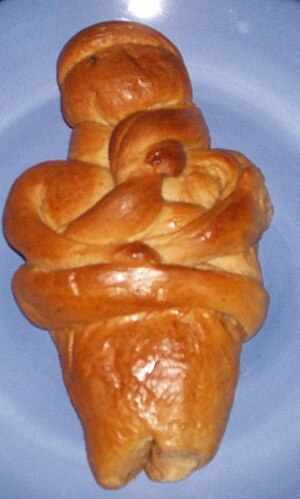food.wikisort.org - Dish
Lazarákia (Greek: Λαζαράκια, "Little Lazaruses") are small, sweet spice breads made in Greece and Cyprus by Orthodox Christians on Lazarus Saturday, the Saturday that begins Holy Week. They are eaten to celebrate the miracle of Jesus raising Lazarus from the dead. They are shaped like a man wrapped in a shroud, supposedly Saint Lazarus of Bethany, with cloves for eyes. They contain several sweet spices and are a fasting Lenten food, meaning that they do not contain any dairy products or eggs. For that reason, unlike the tsourekia, they are brushed with olive oil instead of egg or butter for a gloss finish.[1][2]
 Lazarakia on a plate | |
| Type | Sweet bread |
|---|---|
| Place of origin | Greece and Cyprus |
| Main ingredients | Sweet spices |
Women in Lipsi were symbolically equated with the Virgin Mary and part of the symbolism of Holy Week was that of death experienced through motherhood. Though in modern times lazarákia are mostly purchased at the bakery, in past times women would knead the dough for the lazarákia, shaped in human form, as the symbol of life overcoming death. One of the lazaráki would be kept in the home for the entire year and either eaten the following year or thrown into the sea to be eaten by fish.[3]
References
- "Lazarakia (Lazarus Bread)". 31 March 2015. Retrieved 2018-03-18.
- "Lazarakia – Traditional Bread for the Saturday of Lazarus". Retrieved 2018-03-18.
- Papachristophorou, Marilena (17 December 2013). Myth, Representation, and Identity: An Ethnography of Memory in Lipsi, Greece. Palgrave Macmillan. pp. 97–98. ISBN 9781137362759.
На других языках
- [en] Lazarakia
[ru] Лазаракия
Лазаракия (греч. Λαζαράκια, «лазарчики») — греческая обрядовая выпечка, сладкие булочки, которые пекут в Греции и на Кипре православные христиане в Лазареву субботу, с которой начинается Страстная неделя. Их едят, чтобы отпраздновать чудо, когда Иисус воскресил Лазаря из мертвых. Они имеют форму человека, закутанного в саван, как бы святого Лазаря из Вифании, с гвоздикой вместо глаз. Содержат несколько специй, не содержат молочных продуктов или яиц, и являются постной едой. По этой причине, в отличие от цуреки, они смазываются оливковым маслом, а не яйцом или маслом для придания блеска[1][2].Другой контент может иметь иную лицензию. Перед использованием материалов сайта WikiSort.org внимательно изучите правила лицензирования конкретных элементов наполнения сайта.
WikiSort.org - проект по пересортировке и дополнению контента Википедии